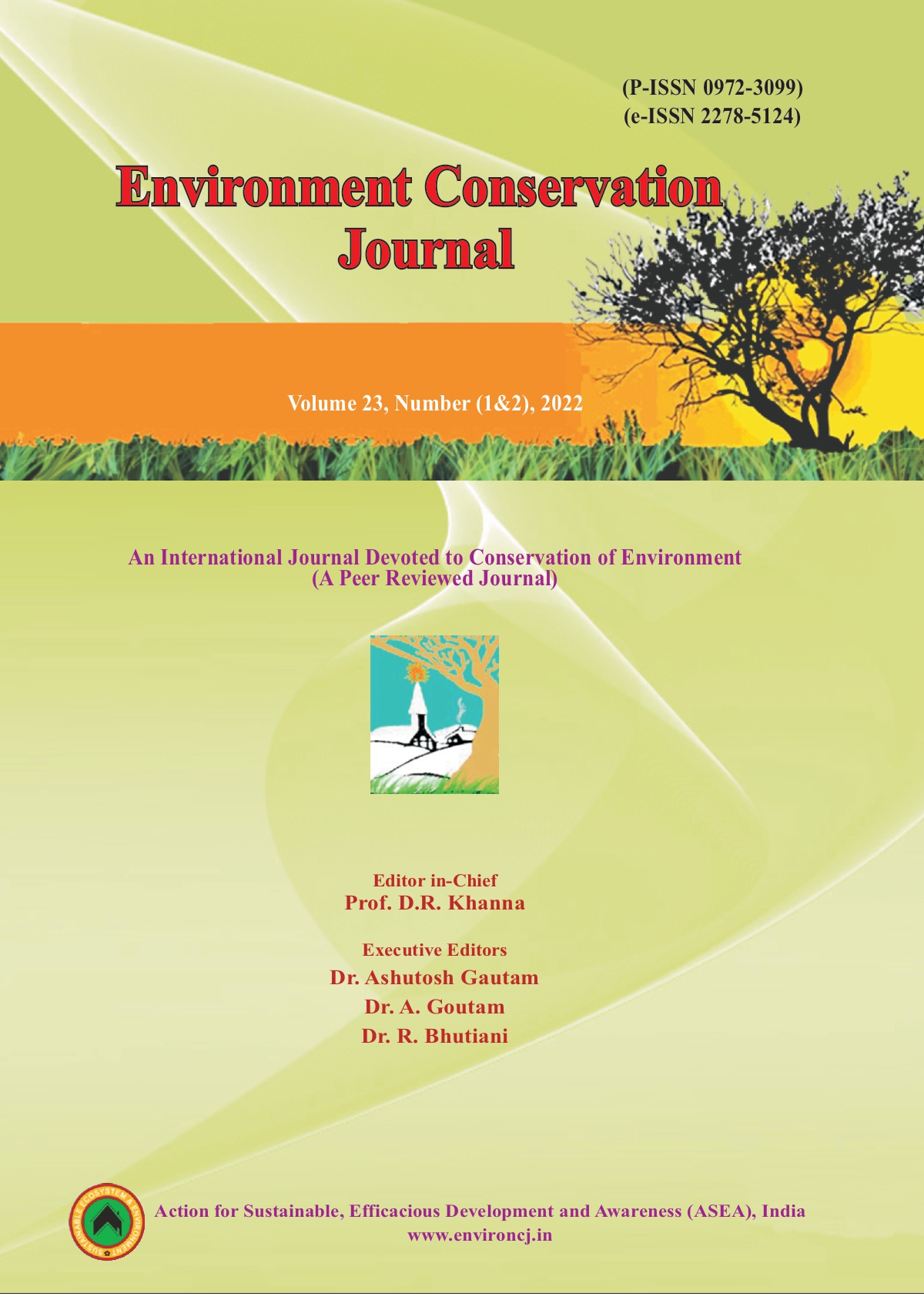Main Article Content
Abstract
Natural color cotton is eco-supportive as they possess colour naturally in varied shades viz., brown, green, cream and other tints and shades of these colours. It has unique comfort and handle property which provides soothing to the wearer. A medium brown natural colour cotton fibre was spun into 20s count yarn on open end spinning and the pure colour cotton fabric was developed on handloom and subjected to scouring. The scoured natural colour cotton fabric undergone with multiple wash cycles and assessed for mechanical, functional properties, colour fastness to sunlight and washing properties. Results revealed that, the scoured natural color cotton fabrics at washing and sunlight was found to be increase in color strength and decrease in reflectance than the pure NCC fabric. After laundering at multiple washes, the scoured natural colour cotton fabric exposed to direct sunlight, it was found that the colour strength was significantly reduced and fabric became lighter, duller and yellower. However, the scoured natural colour cotton fabric subjected to washing and shade dried exhibited significantly greater K/S, which indicates the sample became darker, brighter and greener than the sample expose to direct sunlight. The natural colour cotton fabrics has better mechanical, functional and fastness properties can be suitable for production of diversified cotton products ranging from children garments to trendy outfits. Hence, the promotion of natural colour cotton fabrics is a sustainable approach for green environment.
Keywords
Article Details
Copyright (c) 2022 Environment Conservation Journal

This work is licensed under a Creative Commons Attribution-NonCommercial 4.0 International License.
References
- Gandhad, R. S., & Naik, S. D., (1999). Naturally Coloured Cotton: scouring effect on yarn. The Indian Textile Journal, 109: 44-45.
- Gohl, E. P. G., & Vilensky, L. D., (2005). Textile science-An explanation of fibre properties. CBS publishers and distributors Pvt. Ltd., New Delhi, India.
- Hsieh. Y. L., (2007). Chemical structure and properties of cotton. Y. L. H. S. I. E. H., University of California, USA, Pp-1-33. DOI: https://doi.org/10.1533/9781845692483.1.3
- Magadi, R. B., (2002). Studies on the effect of scouring, bleaching, mercerization and cleansing agents on physical properties of naturally coloured cotton and white cotton yarn. MHSc Thesis, University of Agricultural Sciences Dharwad, Karnataka (India).
- Najwa, A. A. N., (2019). Effect of different wet processing stages on physical properties of cotton woven fabrics. Fibres and Textiles, 4 :13-18.
- Parmar, M. S., & Sharma, R. P., (2002). Development of various colours and shades in naturally coloured cotton fabrics. Indian Journal of Fibre & Textile Research, 27:391-407.
- Prabaharan, M., & Rao, J. V., (2003). Combined desizing, scouring and bleaching of cotton using zone. Indian Journal of Fibre and Textile Research, 28: 437-443.
- Ramesh Babu B., Parande A.K., Raghu S., & Prem Kumar., (2007). Textile Processing: Waste Generation and Effluent Treatment. The Journal of Cotton Science 11:141–153.
- Rathinamoorthy R., & M. Parthiban., (2019). Colored Cotton: Novel Eco-friendly Textile Material for the Future. Handbook of Eco-materials, Pp- 1499-1519. DOI: https://doi.org/10.1007/978-3-319-68255-6_91
- Shrikant, V., Pragna, K., Someshwar, B., & Ashutosh, M., (2005). Effect of scouring and dyeing on physical properties of the fabric. Journal of the Textile Association, 173-175.
- Tsalikia, E., Kechagiab, U., Eleftheriadisc, I., & Xanthopoulosd, F., (2016). Effect of wet treatments on color fastness of naturally colored cotton. Journal of Natural Fibers, 13: 502–505. DOI: https://doi.org/10.1080/15440478.2015.1069234
- Uddin, F., & Lomas M., (2010). Wettability of Easy-Care Finished Cotton. Fibres and Textiles in Eastern Europ, 18 (81): 56-60.
References
Gandhad, R. S., & Naik, S. D., (1999). Naturally Coloured Cotton: scouring effect on yarn. The Indian Textile Journal, 109: 44-45.
Gohl, E. P. G., & Vilensky, L. D., (2005). Textile science-An explanation of fibre properties. CBS publishers and distributors Pvt. Ltd., New Delhi, India.
Hsieh. Y. L., (2007). Chemical structure and properties of cotton. Y. L. H. S. I. E. H., University of California, USA, Pp-1-33. DOI: https://doi.org/10.1533/9781845692483.1.3
Magadi, R. B., (2002). Studies on the effect of scouring, bleaching, mercerization and cleansing agents on physical properties of naturally coloured cotton and white cotton yarn. MHSc Thesis, University of Agricultural Sciences Dharwad, Karnataka (India).
Najwa, A. A. N., (2019). Effect of different wet processing stages on physical properties of cotton woven fabrics. Fibres and Textiles, 4 :13-18.
Parmar, M. S., & Sharma, R. P., (2002). Development of various colours and shades in naturally coloured cotton fabrics. Indian Journal of Fibre & Textile Research, 27:391-407.
Prabaharan, M., & Rao, J. V., (2003). Combined desizing, scouring and bleaching of cotton using zone. Indian Journal of Fibre and Textile Research, 28: 437-443.
Ramesh Babu B., Parande A.K., Raghu S., & Prem Kumar., (2007). Textile Processing: Waste Generation and Effluent Treatment. The Journal of Cotton Science 11:141–153.
Rathinamoorthy R., & M. Parthiban., (2019). Colored Cotton: Novel Eco-friendly Textile Material for the Future. Handbook of Eco-materials, Pp- 1499-1519. DOI: https://doi.org/10.1007/978-3-319-68255-6_91
Shrikant, V., Pragna, K., Someshwar, B., & Ashutosh, M., (2005). Effect of scouring and dyeing on physical properties of the fabric. Journal of the Textile Association, 173-175.
Tsalikia, E., Kechagiab, U., Eleftheriadisc, I., & Xanthopoulosd, F., (2016). Effect of wet treatments on color fastness of naturally colored cotton. Journal of Natural Fibers, 13: 502–505. DOI: https://doi.org/10.1080/15440478.2015.1069234
Uddin, F., & Lomas M., (2010). Wettability of Easy-Care Finished Cotton. Fibres and Textiles in Eastern Europ, 18 (81): 56-60.





